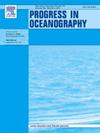Testing hypotheses to explain a surprisingly large year-class of walleye pollock in an ice-free subarctic southeastern Bering Sea; a review of available data
IF 3.6
3区 地球科学
Q1 OCEANOGRAPHY
引用次数: 0
Abstract
Several hypotheses link year-class-strength of eastern Bering Sea walleye pollock (Gadus chalcogramus) to climate variability. These focus on positive relationships with sea ice as a substrate for ice algae, as a water column stabilizer, and as a determinant of a cold pool. In 2018, sea ice was absent over the outer and middle Bering Sea shelf south of 60°N and therefore the 2018 year-class of pollock was expected to be small. However, the 2018 year-class of pollock is estimated to be the most abundant on record. We evaluated three, non-mutually exclusive hypotheses to account for the unexpected strength of the 2018 pollock year-class, 1) reduced predation on age-0 pollock, 2) reduced competition for zooplankton prey, and 3) cross-shelf transport of zooplankton in spring. We found that the northward movement of age-1 and older pollock out of the southeastern Bering Sea reduced the potential for predation on age-0 pollock over the southern shelf, as well as the potential for competition for zooplankton prey there. In contrast, the cross-shelf advection of zooplankton in spring did not appear to have influenced prey availability for age-0 pollock in late summer and fall. Thus, the northward movement of a large fraction of both age-1 as well as older pollock, not seen in the past, was at least a major contributor to the unique occurrence of an exceptionally strong year class in a warm year, 2018. As the Bering Sea warms, and if age-1+ pollock migrate northward after spawning in the southeastern Bering Sea as in 2018, it is possible that eastern Bering Sea pollock will maintain moderate to strong year-classes despite the loss of sea ice.
测试假设,以解释白令海东南部无冰的亚北极地区出现的令人惊讶的大型狭鳕;对现有数据的回顾
有几种假说认为东白令海白眼狭鳕(Gadus chalcogramus)的年强度与气候变率有关。这些研究集中在海冰作为冰藻的基质、水柱稳定剂和冷池的决定因素与海冰的积极关系上。2018年,60°N以南的白令海陆架外部和中部没有海冰,因此2018年 年级的鳕鱼预计会很小。然而,据估计,2018年 年的鳕鱼数量是有史以来最多的。我们评估了三个不相互排斥的假设,以解释2018年鳕鱼的意外强度,1)0岁的鳕鱼捕食减少,2)浮游动物猎物的竞争减少,3)春季浮游动物的跨大陆架运输。我们发现,1岁及更老的鳕鱼从白令海东南部向北移动,减少了在南部大陆架上捕食0岁鳕鱼的可能性,也减少了争夺那里浮游动物猎物的可能性。相比之下,春季浮游动物的跨大陆架平流似乎没有影响夏末和秋季0岁狭鳕的猎物可得性。因此,在过去从未见过的1岁和较老的狭鳕的很大一部分向北移动,至少是2018年温暖年份出现异常强劲年份的主要原因。随着白令海变暖,如果1岁以上 鳕鱼像2018年一样在白令海东南部产卵后向北迁徙,那么尽管海冰减少,白令海东部狭鳕仍有可能保持中等到强烈的年度种群。
本文章由计算机程序翻译,如有差异,请以英文原文为准。
求助全文
约1分钟内获得全文
求助全文
来源期刊

Progress in Oceanography
地学-海洋学
CiteScore
7.20
自引率
4.90%
发文量
138
审稿时长
3 months
期刊介绍:
Progress in Oceanography publishes the longer, more comprehensive papers that most oceanographers feel are necessary, on occasion, to do justice to their work. Contributions are generally either a review of an aspect of oceanography or a treatise on an expanding oceanographic subject. The articles cover the entire spectrum of disciplines within the science of oceanography. Occasionally volumes are devoted to collections of papers and conference proceedings of exceptional interest. Essential reading for all oceanographers.
 求助内容:
求助内容: 应助结果提醒方式:
应助结果提醒方式:


